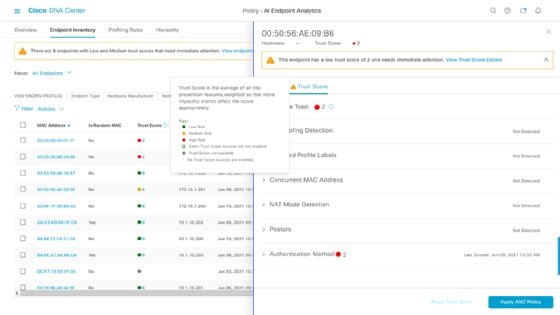
Rymden - stock.adobe.com
Cisco DNA Center update tackles customer headaches
The latest DNA Center upgrade simplifies deploying the campus network controller and scaling the platform to handle more endpoints. Cisco plans to release it in mid-June.
Network engineers have complained of the difficulties in installing and scaling Cisco's DNA Center since its introduction in 2017. In the latest release, Cisco takes on those problems head-on.
Cisco introduced this week version 2.2.2 of the central controller for the company's software-based campus networking architecture. Updates to the platform -- available in mid-June -- include a faster setup process and double the number of endpoints it can handle in a high-capacity configuration. Cisco also improved Wi-Fi visibility.
"One of the early complaints I heard from customers about DNA Center was that it was an immature product," said Shamus McGillicuddy, an analyst at Enterprise Management Associates. "It was difficult to get it up and running and not quite scalable enough. The platform updates in this new version address that directly."
Network engineers have griped about deploying an overly complicated DNA Center as late as 2020. In the latest update, Cisco introduced a 30-minute setup process for turning on the software. The install configuration wizard provides access to the product's most used features.
Cisco streamlined the configuration requirements for disaster recovery from seven nodes to three and doubled DNA Center's endpoint capacity to accommodate more IoT devices. Also, the product can upgrade up to 1,000 Catalyst 9000 devices every hour, according to Cisco.
Improvements for SD-Access, ThousandEyes
The update has customization tools for enterprises with traditional Layer 2 access networks. The feature lets organizations transition to Cisco's Software-Defined Access (SD-Access) in incremental steps to avoid network disruptions. A component within DNA Center, SD-Access provides the tools for configuring Cisco's Catalyst 9000 access switches for threat containment and endpoint segmentation and analytics.
The latest DNA Center also has anomaly detection. Through SD-Access, the system can monitor endpoint behavior and continuously cross-reference it with the norm. DNA Center assigns an endpoint numerical trust score that network operators use to decide whether to quarantine or remove a device.

Cisco simplifies attaching its ThousandEyes internet intelligence technology to the Catalyst 9000 in the DNA Center upgrade. The software provides a one-click option to install ThousandEyes agents on all supporting access switches at once, Cisco said.
Renown Health, a healthcare network based in Reno, Nev., is a DNA Center customer Cisco introduced at a recent media and analyst briefing. Dustin Metteer, a Renown network engineer, appreciated the ThousandEyes feature because the previous process for agent deployment was "kind of slow."
Cisco has added Ekahau integration in DNA Center to assist network architects in choosing the number and location of access points to provide the best wireless coverage. The integration lets architects export floor plans to Ekahau's Wi-Fi design software and import the results back to DNA Center.
"That's really something that will save us time, effort and money throughout the entire wireless [installation] process," Metteer said.
Better Wi-Fi visibility
Cisco introduced Wi-Fi coverage heatmaps to DNA Center that track key performance indicators (KPIs) hourly. The tracking lets engineers find and isolate problems faster and perform root cause analysis.
"If there's an issue with wireless, we can jump into it and see what's going on literally in two or three minutes," said Shai Silberman, the network services director at San Jose State University in California. Silberman joined Metteer as a customer reference at the briefing.
Cisco added return-on-investment reports that help justify DNA Center's cost. The data shows the amount of money and time spent with and without the product. Companies can compare their numbers with other organizations in the same industry or geographic area.
Overall, the latest features in DNA Center are not "game-changers or transformative," said Gartner analyst Andrew Lerner. "I view these as solid incremental updates to DNAC that should drive improved ease of use."





